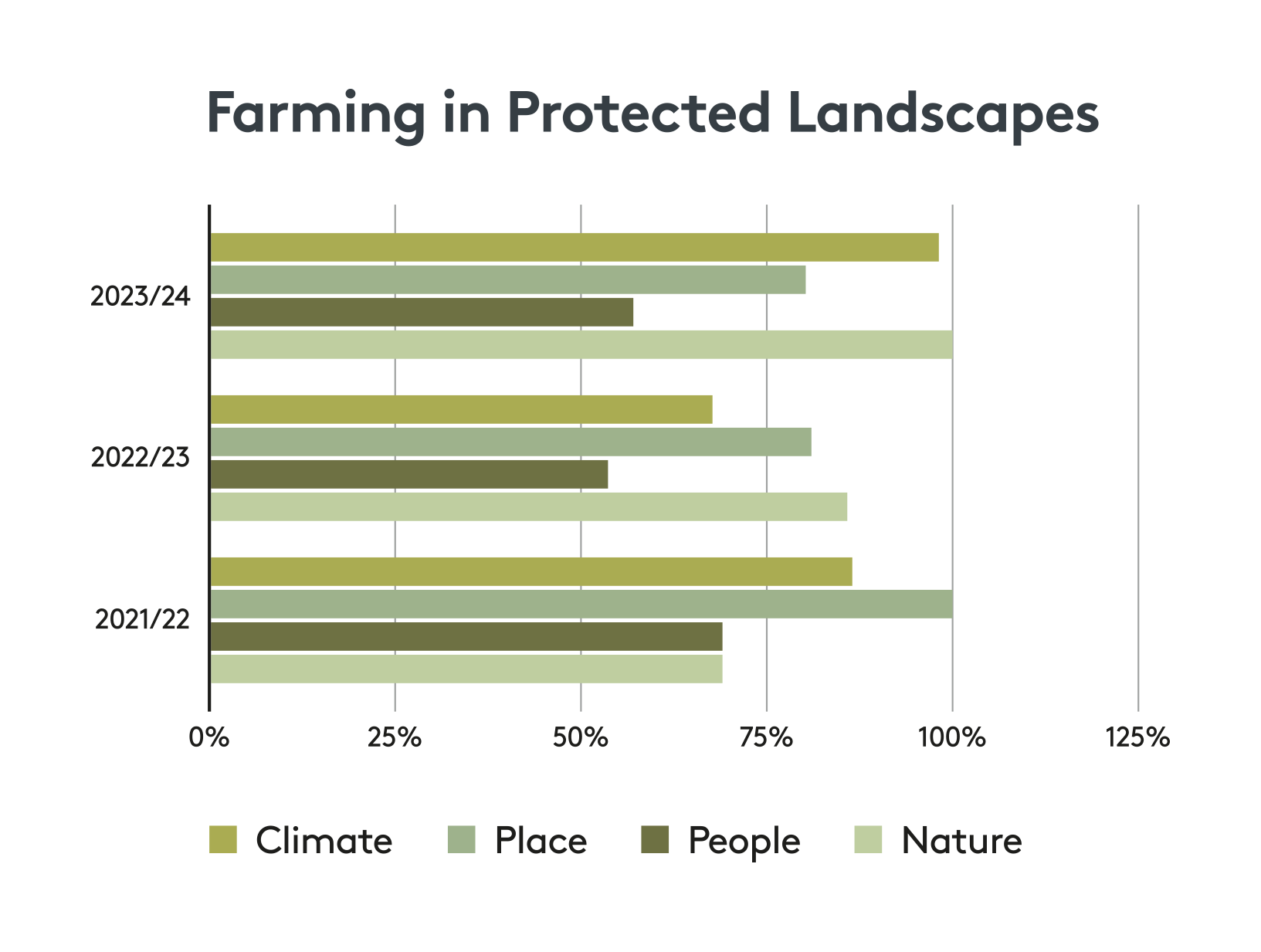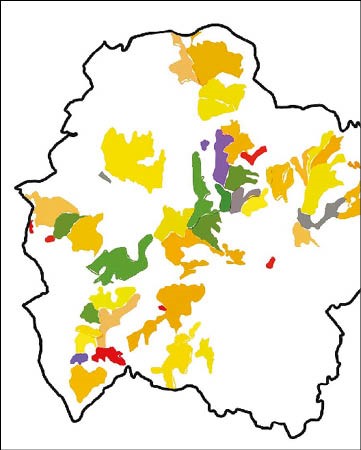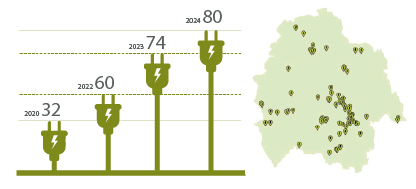
This section is the appendix of the Lake District Partnership Plan.
Action 1: Using evidence from the Carbon Budget and other sources, lobby Government to develop new net zero incentives to re-trigger an acceleration in renewable energy production. (We have not lobbied government on this issue but have, for the first time, established data for energy consumption and use of renewable sources in the park: see infographic below. Lead Partner: LDNPA)
Infographic: shows the renewable energy generated in the Lake District (from wind turbines and solar panels) as a percentage (24%) of the overall energy consumed (983,840 Mega-watt hours)
Action 2: Lobbying Government to reduce VAT on the maintenance, repair and retrofitting of traditional buildings as a pilot in the Lake District (See case study on Climate Action page 'Lobbying government on VAT for repair/retrofit'. Lead Partner: LDNPA)
Action 3: By March 2024 secure agreement, by all partners, on significantly reducing carbon emissions through business planning and delivering of caron savings by integrating climate action into their business plans. (100% of Partners are addressing and delivering climate action through their business plans but more work needs to be done to understand the detail of this commitment. Lead Partner: LDNPA)
Action 4: By June 2024 develop and agree a pipeline of new Zero Carbon Cumbria Partnership sector projects for climate action to move towards addressing the gap identified that can feasibly by implemented in the next 10, 15, 20 years. (See case study on Climate Action page ‘Zero Carbon Cumbria Partnership’s Sector Groups’)
Action 5: Empowering locally led climate action by creating a network of ‘climate champions’ with communities by working with Zero Carbon Cumbria Partnership to support the delivery of local projects and community action. (This action has not been progressed due to a lack of resources. Lead Partner: LDNPA)
Action 1: Develop and deliver a coordinated Partnership transition support programme to enable business adaption, nature and climate recovery and maintenance of the cultural landscape and supporting young entrants by securing the high take-up of options within the Government’s Agricultural Transition Plan 2021-2024, through:

Graph: shows the number of projects delivering against the four FiPL themes: some projects have delivered against more than one

Graph: number of farmers and projects benefiting from the Farming in Protected Landscape Programme

Graph: percentage of land under agri-environmental agreements between 2018 and 2023

Infographic: number of blended finance projects in the Lake District National Park (Baseline 2022-23=9, 2023-24=5 in development)
Action 2: Make on-the-ground contributions to deliver the Cumbria Local Nature Recovery Strategy by developing the Lake District National Park Nature Recovery Prospectus and delivering it through:

Infographic: area in hectares of core recovery areas (19.9% of the area of the Lake District National Park)
 Graph: Peatland restoration in the Lake District National Park (total site area in hectares from 2020 to 2023 and cumulative total, area of peatland restored and peatland surveyed with restoration plans)
Graph: Peatland restoration in the Lake District National Park (total site area in hectares from 2020 to 2023 and cumulative total, area of peatland restored and peatland surveyed with restoration plans)

Graph: carbon sequestered in restored peatland from 2020 to 2023
Action 3: Reduce the contributions from farming and land management make to greenhouse gas emissions in line with the National Farmers Union net zero goal and support farmers and land managers on adaptation by:

Infographic: number of farmers who undertook carbon business audits in 2023-24
Action 4: Maintain, celebrate and strengthen traditional Lake District farming systems by:
Concentration of Hefting on Commons in the Lake District
 Graph: concentration of hefting on Commons in the Lake District
Graph: concentration of hefting on Commons in the Lake District


Maps: Heft Map 2017 (left) and 2022 (right). The key to these maps is the same as the graph above.
Percentage of Commons in Agri-environment Schemes

Graph: pie charts depicting percentage of Commons in agri-environmental schemes: this is the first time we have been able to report on this
Action 5: Deliver actions to improve the water environment of Lake Windermere. Resources and projects are being coordinated through the Love Windermere Partnership (See case study on Future of Farming page ‘Love Windermere')
Action 1: Create a dedicated Engagement and Outreach Team to provide progressive opportunities for engagement to target underserved groups either in local outdoor spaces or in the Lake District itself. The Engagement and Outreach Team will then identify priority activity to ensure the Lake District is a place for everyone whether connected through association or by a physical visit. (It has been agreed that the Key Outcome Group replaces the Engagement and Outreach Team concept. The KOG has identified priority projects for the remainder of the Plan period some of which are described as case studies in the main part of this report. Source: Lake District National Park Authority.)
Action 2: Ensure the Lake District is welcoming for all by:
Action 1: Advocate and support initiatives for multi-modal ticketing and enhanced connectivity from the West Coast Mainline between Penrith and Keswick and from Oxenholme and Windermere Stations. (A Park and Sail scheme has been delivered (boat and bus) and a Rail-Bus scheme is in development. Lead Partner: LDNPA)
Action 2: Lobbying and working with relevant bodies and organisations to support proposals for funding and delivery of following rail upgrades:
| Station | North bound Mon-Fri | South bound Mon-Fri | Weekly |
|---|---|---|---|
| Penrith | 32 | 30 | 31 |
| Oxenholme | 40 | 38 | 43 |
| Either or both | 46 | 46 | 44 |
| Station | North bound Saturday | South bound Saturday | North bound Sunday | South bound Sunday | Weekly |
|---|---|---|---|---|---|
| Penrith | 31 | 29 | 28 | 25 | 423 |
| Oxenholme | 43 | 39 | 35 | 32 | 539 |
| Either or both | 44 | 42 | 37 | 37 | 620 |
Table: Monitoring the numbers of services operating, on different days of the week, helps the Partnership to understand whether or not rail services that allow passengers to access the Lake District are increasing, decreasing or stable over time.
| Station | North bound Mon-Fri | South bound Mon-Fri | Weekly |
|---|---|---|---|
| Penrith | 32 | 30 | 31 |
| Oxenholme | 40 | 38 | 43 |
| Either or both | 46 | 46 | 44 |
| Station | North bound Saturday | South bound Saturday | North bound Sunday | South bound Sunday | Weekly |
|---|---|---|---|---|---|
| Penrith | 31 | 29 | 28 | 25 | 423 |
| Oxenholme | 43 | 39 | 35 | 32 | 539 |
| Either or both | 44 | 42 | 37 | 37 | 6 |
Table: Monitoring the numbers of services operating, on different days of the week, helps the Partnership to understand whether or not the number of services stopping at Penrith and Oxenholme are increasing, decreasing or stable over time.
Action 3: Develop marketing and ticketing initiatives for all sustainable and active transport modes. All Partners to promote sustainable travel through their own communications. (Data on sustainable travel usages has not been updated since last year’s annual report: the next visitor survey looking at transport choices will take place in 2025. Lead Partner: LDNPA)
Action 4: Work in partnership to secure the decarbonisation of transport including:

Infographic: electric charging points in the Lake District from 32 in 2020 to 80 in 2024

Infographic: 8.5% of visitors travelled here by EV or hybrid vehicle, with 5.9% using them to travel around while they were here.
Action 5: Develop high quality active travel measures including:
Action 6: Work with communities to pilot sustainable travel improvements. (See example case study on Sustainable Travel and Transport page ‘Community Sustainable Travel pilots’)
Action 1: Lobby Homes England to make the social rent funding available for all relevant housing schemes throughout the Lake District not just South Lakeland by 2022. (This is no longer a live action due to changes in social rent funding. Lead Partner: LDNPA)
Action 2: Lobby central Government to agree to introduce a mechanism to control the conversion of first to second homes in the Lake District, and to remove the small business rates exemption for furnished holiday homes by 2023. (See statement on Vibrant Communities and a Prosperous Economy page ‘Removal of Small Business Rate exemption’)
Action 3: Lobby mortgage lenders to agree to be more flexible when lending on properties with local occupancy controls, and review annually. (See statement on Vibrant Communities and a Prosperous Economy page ‘Number of Key Mortgage Lenders that are flexible on lending’)
Action 4: Deliver the projects within the Windermere Gateway area to improve Windermere Station, and deliver affordable housing (circa 160 units) and employment space through:
Action 5: Continue to support the multi-agency visitor management response to the Covid-19 pandemic including delivering the Visitor Management Tactical Action Plans. (The Strategic Visitor Management Group has signed off its Tactical Action Plan 2024 and is making preparations for the 2024 season. This includes agreeing the release of funds towards certain interventions, maximising wherever possible other funding opportunities, including the Bus Service Improvement Fund. Lead Partner: Cumbria Tourism. Economic Value of tourism data has not changed since that reported in 2022-23 with the next data set due in 2024; although see statement and graph on the economic trajectory on Vibrant Communities and a Prosperous Economy page ‘Economic Value of Tourism’)
Action 6: Work with businesses, transport operators and infrastructure providers to help connect people with jobs in rural areas they couldn’t otherwise take through the provision of an effective and innovative rural bus service. (Westmorland and Furness Council has received £750,000 as part of the Rural Mobility Fund to enhance the provision of demand responsive transport services. New services will serve a 10-mile radius of Ulverston and 15-mile radius of Penrith. Lead Partner: Westmorland & Furness Council)
Action 7: Secure private financing in natural capital drawing on the partnerships investment ready schemes, including working through the National Park’s Partnerships Net Zero for Nature programme. (No data available in 2023-24, Lead Partner: Lake District Foundation; this action is now - 2024-25 - being taken forward through the Farming, Forestry, Nature and Climate Key Outcome Group.)
Action 8: To maximise the opportunities presented by the Project Gigabit Cumbria pilot project to connect gigabit capable broadband in hard to reach premises in the Lake District.

Infographic: number of dwellings in the Lake District National Park in 2023 with broadband. (3.1% USO <10Mbps, 83.6% Superfast >30Mbps, 10% have gigabit connectivity)

Infographic: number of dwellings in the Lake District National Park in 2024 with broadband. (2.6% USO <10Mbps, 86% Superfast >30Mbps, 297% have gigabit connectivity)£928k of digital borderlands or Cumbria County Council top-up paid or allocated in the Lake District
Action 9: For those premises which will not be covered by Project Gigabit, we will work with communities to help promote the opportunity presented by suppliers to connect rural communities to gigabit capable broadband. (Connecting Cumbria top-up funding remains available to premises with less than 30Mbps download providing up to £7,000 per small to medium-sized enterprises (SME) and £3,000 per residential beneficiary. There is also on-going supplier engagement including with B4RN and Openreach and on-going community engagement. Lead partner: Connecting Cumbria)
Action 10: Monitor 4G coverage in the National Park as the shared Rural network delivers and assess whether further intervention is required so that no-one and no place is left behind.

Infographic: 47.8% of the Lake District has 4G coverage
This report has been compiled and edited by Veronica Fiorato, Partnership Manager for the Lake District National Park Partnership, with support from Lois Mansfield, Environmentors consultancy. Numerous Partners and officers of the Lake District National Park Authority have assisted with particular mention going to Tim Duckmanton, Andrew Herbert, Hanna Latty, Emma Moody, Chloe Swift, Mairi Lock, Eleanor Kingston, Rose Lord and Adrian Anderson. The source of data and case studies have been acknowledged throughout the report, where not supplied by the Lake District National Park Authority.
Natalie Whiteside (LDNPA) produced web layout support and advanced publishing while Emily Rushworth (LDNPA) provided digital imagery. Additional graphics and design was by Matthew Richardson at Mr* Letters.
Thanks must also go to Steve Tonkin of the Lake District Foundation for newly building the Partnership’s Dashboard to allow the digital gathering of data and case studies for this year’s report and going forward.